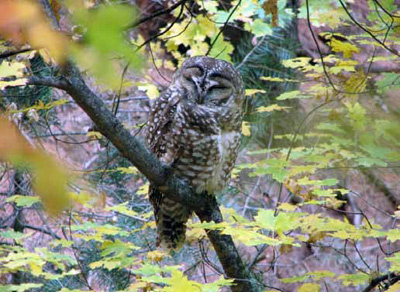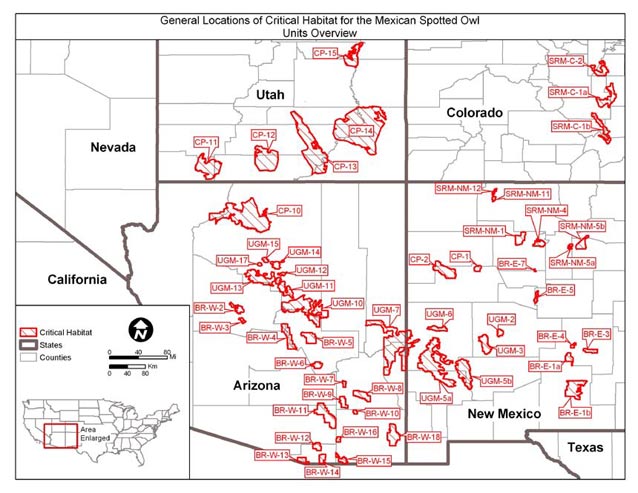The Mexican spotted owl, one of the largest owls in North America, is listed as a threatened species by both the U.S. and Mexican governments.
Taxonomy
The Mexican spotted owl (Strix occidentalis lucida) is one of three subspecies of spotted owl that include the northern spotted owl (S. o. caurina) and the California spotted owl (S. o. occidentalis), and is geographically isolated from each. Plumage and geographic distribution distinguish the Mexican spotted owl from the California and northern subspecies.
Description

Apache Sitgreaves National Forest
The Mexican spotted owl ranks as one of the largest owls in North America—of the 19 species that occur, only 4 are larger. The average length is 41-48 cm (16-19 inches); average wingspan is 107-114 cm (42-45 inches); and average weight is 547-647 grams (19.5-23 ounces). The subspecies exhibits reversed sexual dimorphism—the females are larger than males and are, on average, 100 grams heavier.
Male and female Mexican spotted owls are similar in appearance— brown with irregular brown and white spots on the abdomen, back, and head. Because the spots are larger than those of other spotted owls, they appear to be lighter. Unlike most owls, Mexican spotted owls have dark eyes. The brown tail is marked with several thin white bands.
Distribution

U.S. Fish and Wildlife Service. Mexican spotted owl recovery plan, 1995
The Mexican spotted owl has the largest geographic range of the three subspecies. The range extends from the southern Rocky Mountains in Colorado and the Colorado Plateau in southern Utah southward through Arizona and New Mexico and discontinuously through the Sierra Madre Occidental and Oriental to the mountains at the southern end of the Mexican Plateau. Thorough surveys have been completed in west central Arizona, southern New Mexico, and many of the canyon systems of southern Utah (see David Willey et al.). Very little is known of the owl’s range and distribution in Mexico.
Habitat Associations

Zion National Park
Mexican spotted owls nest, forage, roost, and disperse in a wide variety of biotic communities:
- Mixed-conifer forests are commonly used throughout the range and may include Douglas fir, white fir, southwestern white pine, limber pine, and ponderosa pine. Understory may include Gambel oak, maples, box elder, and/or New Mexico locust. Highest densities of Mexican spotted owls occur in mixed-conifer forests that have experienced minimal human disturbance.
- Madrean pine-oak forests are commonly used throughout the range, and, in the southwestern U.S., are typically dominated by an overstory of Chihuahua and Apache pines, with species such as Douglasfir, ponderosa pine, and Arizona cypress. Evergreen oaks are typically prominent in the understory.
- Rocky canyons are utilized by Mexican spotted owls in the northern part of their range, including far northern Arizona and New Mexico, and southern Utah and Colorado.
Nesting habitat is typically in areas with complex forest structure or rocky canyons, and contains mature or old growth stands which are uneven-aged, multistoried, and have high canopy closure. In the northern portion of the range (southern Utah and Colorado), most nests are in caves or on cliff ledges in steep-walled canyons. Elsewhere, the majority of nests are in Douglas-fir trees (Pseudotsuga menziesii).
The patterns of habitat use by foraging owls are not well known, but Mexican spotted owls generally forage in a broader array of habitats than they use for roosting, and most commonly in Douglas fir. Ganey and Balda (1994) found that, in northern Arizona, owls generally foraged slightly more than expected in unlogged forests, and less so in selectively logged forests. However, patterns of habitat use varied between study areas and between individual birds, making generalizations difficult.
Life History
Outside of the breeding season, Mexican spotted owls are generally solitary. Their home ranges vary from a few hundred hectares to 1,500 hectares. Some may migrate between breeding and winter seasons, travelling 20-50 km; or they may migrate vertically from high elevations to lower elevations in winter. These owls tend to exhibit high fidelity to their home ranges.
Juveniles leave their natal territory in September. Dispersing juveniles are found in a variety of habitats, ranging from high-elevation forests to pinyon-juniper woodlands and riparian areas surrounded by desert grasslands. Some juveniles remained in forests similar to typical owl breeding habitat. Through the first winter, some juveniles will travel through a variety of vegetation communities, remaining in one area for several weeks before moving on.
Mexican spotted owls roost during the day and hunt at dusk and at night. They may leave the roost during day to capture prey beneath their roost, retrieve cached prey, or to drink or bathe in a stream.
The average actual life expectancy for Mexican spotted owls in the wild is about 15 years.
Feeding Habits
Owls forage primarily at night, starting at sunset and continuing until just before sunrise. Mexican spotted owls feed on small mammals, particularly mice, voles, and woodrats, and will also take birds, bats, reptiles and arthropods.
They generally perch, detect prey by sight or sound, and then pounce on their prey, capturing it with their talons. They also can take prey on the wing, particularly birds.
Reproductive Biology

Photo by Steve Howe
Mexican spotted owls are monogamous and generally form long-term bonds with their mates. The reproductive chronology varies somewhat across their range. In Arizona, courtship begins in March and the female lays 2-4 eggs in late March to early April. She is solely responsible for their incubation, which typically lasts 30 days. The males do most or all of the foraging for food. The eggs hatch in early May, and the nestling owls usually fledge 4-5 weeks later. The young are dependent upon their parents for food through the summer and eventually disperse from the natal area in fall.
Conservation Assessment

http://www.fws.gov/southwest/es/mso/critical_habitat/compressed/mso_ch_overview_c.jpg
The Mexican spotted owl is listed as a threatened species by both the U.S. and Mexican governments, and is considered threatened in Colorado, Utah, and the Navajo Nation, and a species of Concern in Arizona and New Mexico. Globally, Mexican spotted owl populations are predicted to decline 25–50% over the long-term. In New Mexico, the populations declined 9% through the 1990s. While wide population fluctuations may be common for owls, these owl populations have been negatively affected by the loss, degradation, and fragmentation of their habitat as a result of even-aged timber management, urban and suburban development, agriculture development, water development in riparian areas, and mining.
Mexican spotted owl populations are also threatened by the potential for catastrophic, stand-replacing fire in some areas. Low fecundity, due to small clutch size, variability in nesting success, and delayed onset of breeding, also contributes to the problem of declining Mexican spotted owl populations.
In 2004, the USFWS designated 3.5 million ha (8.6 million ac) of federal lands in Arizona, Colorado, New Mexico, and Utah as critical habitat for the Mexican spotted owl. The Endangered Species Act requires federal agencies to ensure that activities they authorize, fund, or carry out are not likely to destroy or negatively alter critical habitat.
References
Fletcher, K. W. and H.E. Hollis. 1994. Habitats used, abundance, and distribution of the Mexican spotted owl (Strix occidentalis lucida) on Natioanal Forest System lands in the Southwestern Region. USDA For. Serv., Southwestern Region, Albuquerque, N.M.
Gutiérrez, R. J., A. B. Franklin, and W. S. Lahaye. 1995. Spotted Owl (Strix occidentalis). In A. Poole, editor. The Birds of North America Online. Cornell Lab of Ornithology, Ithaca, NY. Available at http://bna.birds.cornell. edu/bna/search?SearchableText=mexican+spotted+owl (accessed 12 May 2010).
Hammerson, G. 2007. Strix occidentalis lucida. NatureServe Explorer: an online encyclopedia of life. Version 7.1. NatureServe, Arlington, VA. Available http://www.natureserve. org/explorer (accessed 17 May 2010).
National Biological Information Infrastructure. Geographic Perspectives, Southwest Species of Greatest Conservation- Need, Mexican Spotted Owl. Available at http://www.nbii. gov/portal/server.pt?open=512&objID=1811&mode=2& in_hi_userid=2&cached=true (accessed 13 May 2010).
Seamans, M.E., and R.J. Gutierrez. 1995. Breeding habitat ecology of the Mexican Spotted Owl in the Tularosa Mountains, New Mexico. The Condor 97:944-952.
U.S. Fish and Wildlife Service (USFWS), Southwest Region, Ecological Services. 2009. Mexican Spotted Owl. USFWS, Albuquerque, NM. Available at http://www.fws.gov/southwest/ es/mso/ (accessed 12 May 2010).
U.S. Fish and Wildlife Service. Mexican Spotted Owl species profile. Environmental conservation online system. Available at http://ecos.fws.gov/speciesProfile/profile/ speciesProfile.action?spcode=B074 (accessed 12 May 2010).
Prepared by Jean Palumbo with assistance from Matt Johnson, Southern Colorado Plateau Network I&M Program, 2010
Last updated: February 3, 2015
